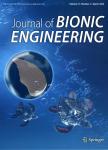Biomimetics of Campaniform Sensilla:Measuring Strain from the Deformation of Holes
Biomimetics of Campaniform Sensilla:Measuring Strain from the Deformation of Holes作者机构:Department of Mechanical EngineeringThe University of BathBath BA2 7AYUK Advanced Concepts TeamEuropean Space Agency2201 AZ NoordwijkThe Netherlands
出 版 物:《Journal of Bionic Engineering》 (仿生工程学报(英文版))
年 卷 期:2007年第4卷第2期
页 面:63-76页
核心收录:
学科分类:080202[工学-机械电子工程] 08[工学] 0802[工学-机械工程]
主 题:campaniform sensillum strain displacement compliance hole remote sensing fibrous composite
摘 要:We present a bio-inspired strategy for designing embedded strain sensors in space structures. In insects, the campaniform sensillum is a hole extending through the cuticle arranged such that its shape changes in response to loads. The shape change is rotated through 90° by the suspension of a bell-shaped cap whose deflection is detected by a cell beneath the cuticle. It can be sensitive to displacements of the order of 1 nm. The essential morphology, a hole formed in a plate of fibrous composite mate- rial, was modelled by Skordos et al. who showed that global deformation of the plate (which can be flat, curved or a tube) induces higher local deformation of the hole due to its locally higher compliance. Further developments reported here show that this approach can be applied to groups of holes relative to their orientation. , The morphology of the sensillum in insects suggests that greater sensitivity can be achieved by arranging several holes in a regular pattern; that if the hole is oval it can be "aimed" to sense specific strain directions; and that either by controlling the shape of the hole or its relationship with other holes it can have a tuned response to dynamic strains. We investigate space applications in which novel bio-inspired strain sensors could successfully be used.



